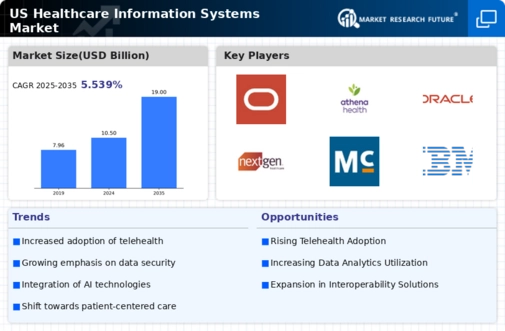Expansion of Cloud-Based Solutions
The expansion of cloud-based solutions is significantly impacting the healthcare information-systems market. Cloud technology offers healthcare organizations the flexibility to scale their operations, reduce IT costs, and enhance collaboration among healthcare providers. As of 2025, it is estimated that over 60% of healthcare organizations are utilizing cloud-based systems for data storage and management. This shift is driven by the need for real-time access to patient information and the ability to share data securely across different platforms. The adoption of cloud solutions is likely to continue growing, as organizations seek to improve efficiency and patient care.
Regulatory Compliance and Standardization
Regulatory compliance is a critical driver in the healthcare information-systems market. The implementation of stringent regulations, such as the Health Insurance Portability and Accountability Act (HIPAA) and the 21st Century Cures Act, necessitates that healthcare organizations adopt robust information systems to ensure data security and interoperability. Compliance with these regulations not only protects patient data but also enhances operational efficiency. As of 2025, it is estimated that over 80% of healthcare organizations are prioritizing investments in information systems that facilitate compliance, indicating a strong market demand for solutions that align with regulatory standards.
Rising Demand for Patient-Centric Solutions
The healthcare information-systems market is experiencing a notable shift towards patient-centric solutions. This trend is driven by an increasing emphasis on personalized care and patient engagement. Healthcare providers are investing in systems that enhance patient experience, streamline communication, and facilitate access to health information. According to recent data, approximately 70% of patients express a preference for digital health solutions that allow them to manage their health proactively. This demand is prompting healthcare organizations to adopt advanced information systems that support telehealth, remote monitoring, and personalized treatment plans, thereby reshaping the landscape of healthcare delivery.
Growing Focus on Data Analytics and Business Intelligence
Data analytics and business intelligence are becoming increasingly vital in the healthcare information-systems market. Organizations are leveraging data analytics to gain insights into patient care, operational performance, and financial management. The ability to analyze data effectively allows healthcare providers to identify trends, optimize resource allocation, and improve patient outcomes. Recent studies indicate that healthcare organizations that utilize advanced analytics are likely to see a 15% increase in operational efficiency. This growing focus on data-driven decision-making is prompting investments in information systems that offer robust analytics capabilities.
Integration of Artificial Intelligence and Machine Learning
The integration of artificial intelligence (AI) and machine learning (ML) technologies is transforming the healthcare information-systems market. These technologies enable healthcare providers to analyze vast amounts of data, leading to improved decision-making and operational efficiencies. AI-driven systems can assist in predictive analytics, patient diagnosis, and treatment recommendations, thereby enhancing clinical outcomes. As of 2025, the market for AI in healthcare is projected to reach $36 billion, reflecting a growing recognition of the potential benefits of these technologies. This trend is likely to drive further investment in information systems that incorporate AI and ML capabilities.





















Leave a Comment